IEEE Std 1364-2001
(Revision of
IEEE Std 1364-1995)
IEEE Computer Society
Sponsored by the
Design Automation Standards Committee
Description Language
s
s IEEE Standard Verilog® Hardware
d
d
r
r
a
a
d
d
n
n
a
a
t
t
S
S
E
E
E
E
E
E
I
I
Published by
The Institute of Electrical and Electronics Engineers, Inc.
3 Park Avenue, New York, NY 10016-5997, USA
28 September 2001
Print: SH94921
PDF: SS94921
�
IEEE Std 1364-2001
(Revision of
IEEE Std 1364-1995)
®
IEEE Standard Verilog
Description Language
Hardware
Sponsor
Design Automation Standards Committee
of the
IEEE Computer Society
Approved 17 March 2001
IEEE-SA Standards Board
¤
Abstract:
Hardware Description Language (HDL) is defined in this standard. Verilog
The Verilog
HDL is a formal notation intended for use in all phases of the creation of electronic systems. Be-
cause it is both machine readable and human readable, it supports the development, verification,
synthesis, and testing of hardware designs; the communication of hardware design data; and the
maintenance, modification, and procurement of hardware. The primary audiences for this standard
are the implementors of tools supporting the language and advanced users of the language.
Keywords:
computer, computer languages, digital systems, electronic systems, hardware, hard-
ware description languages, hardware design, HDL, PLI, programming language interface, Verilog
HDL, Verilog PLI, Verilog
¤
The Institute of Electrical and Electronics Engineers, Inc.
3 Park Avenue, New York, NY 10016-5997, USA
Copyright © 2001 by the Institute of Electrical and Electronics Engineers, Inc.
All rights reserved. Published 28 September 2001. Printed in the United States of America.
Print:
PDF:
ISBN 0-7381-2826-0 SH94921
ISBN 0-7381-2827-9 SS94921
No part of this publication may be reproduced in any form, in an electronic retrieval system or otherwise, without the prior
written permission of the publisher.
�
IEEE Standards
documents are developed within the IEEE Societies and the Standards Coordinating Committees of the
IEEE Standards Association (IEEE-SA) Standards Board. The IEEE develops its standards through a consensus develop-
ment process, approved by the American National Standards Institute, which brings together volunteers representing varied
viewpoints and interests to achieve the final product. Volunteers are not necessarily members of the Institute and serve with-
out compensation. While the IEEE administers the process and establishes rules to promote fairness in the consensus devel-
opment process, the IEEE does not independently evaluate, test, or verify the accuracy of any of the information contained
in its standards.
Use of an IEEE Standard is wholly voluntary. The IEEE disclaims liability for any personal injury, property or other dam-
age, of any nature whatsoever, whether special, indirect, consequential, or compensatory, directly or indirectly resulting
from the publication, use of, or reliance upon this, or any other IEEE Standard document.
The IEEE does not warrant or represent the accuracy or content of the material contained herein, and expressly disclaims
any express or implied warranty, including any implied warranty of merchantability or fitness for a specific purpose, or that
.”
the use of the material contained herein is free from patent infringement. IEEE Standards documents are supplied “
AS IS
The existence of an IEEE Standard does not imply that there are no other ways to produce, test, measure, purchase, market,
or provide other goods and services related to the scope of the IEEE Standard. Furthermore, the viewpoint expressed at the
time a standard is approved and issued is subject to change brought about through developments in the state of the art and
comments received from users of the standard. Every IEEE Standard is subjected to review at least every five years for revi-
sion or reaffirmation. When a document is more than five years old and has not been reaffirmed, it is reasonable to conclude
that its contents, although still of some value, do not wholly reflect the present state of the art. Users are cautioned to check
to determine that they have the latest edition of any IEEE Standard.
In publishing and making this document available, the IEEE is not suggesting or rendering professional or other services
for, or on behalf of, any person or entity. Nor is the IEEE undertaking to perform any duty owed by any other person or
entity to another. Any person utilizing this, and any other IEEE Standards document, should rely upon the advice of a com-
petent professional in determining the exercise of reasonable care in any given circumstances.
Interpretations: Occasionally questions may arise regarding the meaning of portions of standards as they relate to specific
applications. When the need for interpretations is brought to the attention of IEEE, the Institute will initiate action to prepare
appropriate responses. Since IEEE Standards represent a consensus of concerned interests, it is important to ensure that any
interpretation has also received the concurrence of a balance of interests. For this reason, IEEE and the members of its soci-
eties and Standards Coordinating Committees are not able to provide an instant response to interpretation requests except in
those cases where the matter has previously received formal consideration.
Comments for revision of IEEE Standards are welcome from any interested party, regardless of membership affiliation with
IEEE. Suggestions for changes in documents should be in the form of a proposed change of text, together with appropriate
supporting comments. Comments on standards and requests for interpretations should be addressed to:
Secretary, IEEE-SA Standards Board
445 Hoes Lane
P.O. Box 1331
Piscataway, NJ 08855-1331
USA
Note: Attention is called to the possibility that implementation of this standard may require use of subject mat-
ter covered by patent rights. By publication of this standard, no position is taken with respect to the existence or
validity of any patent rights in connection therewith. The IEEE shall not be responsible for identifying patents
for which a license may be required by an IEEE standard or for conducting inquiries into the legal validity or
scope of those patents that are brought to its attention.
The IEEE and its designees are the sole entities that may authorize the use of IEEE-owned certification marks and/or trade-
marks to indicate compliance with the materials set forth herein.
Authorization to photocopy portions of any individual standard for internal or personal use is granted by the Institute of
Electrical and Electronics Engineers, Inc., provided that the appropriate fee is paid to Copyright Clearance Center. To
arrange for payment of licensing fee, please contact Copyright Clearance Center, Customer Service, 222 Rosewood Drive,
Danvers, MA 01923 USA; (978) 750-8400. Permission to photocopy portions of any individual standard for educational
classroom use can also be obtained through the Copyright Clearance Center.
�
Introduction
(This introduction is not part of IEEE Std 1364-2001, IEEE Standard Verilog
Hardware Description Language.)
®
¤
The Verilog
Hardware Description Language (Verilog HDL) became an IEEE standard in 1995 as IEEE
Std 1364-1995. It was designed to be simple, intuitive, and effective at multiple levels of abstraction in a
standard textual format for a variety of design tools, including verification simulation, timing analysis, test
analysis, and synthesis. It is because of these rich features that Verilog has been accepted to be the language
of choice by an overwhelming number of IC designers.
Verilog contains a rich set of built-in primitives, including logic gates, user-definable primitives, switches,
and wired logic. It also has device pin-to-pin delays and timing checks. The mixing of abstract levels is
essentially provided by the semantics of two data types: nets and variables. Continuous assignments, in
which expressions of both variables and nets can continuously drive values onto nets, provide the basic
structural construct. Procedural assignments, in which the results of calculations involving variable and net
values can be stored into variables, provide the basic behavioral construct. A design consists of a set of mod-
ules, each of which has an I/O interface, and a description of its function, which can be structural, behav-
ioral, or a mix. These modules are formed into a hierarchy and are interconnected with nets.
The Verilog language is extensible via the Programming Language Interface (PLI) and the Verilog Proce-
dural Interface (VPI) routines. The PLI/VPI is a collection of routines that allows foreign functions to access
information contained in a Verilog HDL description of the design and facilitates dynamic interaction with
simulation. Applications of PLI/VPI include connecting to a Verilog HDL simulator with other simulation
and CAD systems, customized debugging tasks, delay calculators, and annotators.
The language that influenced Verilog HDL the most was HILO-2, which was developed at Brunel Univer-
sity in England under a contract to produce a test generation system for the British Ministry of Defense.
HILO-2 successfully combined the gate and register transfer levels of abstraction and supported verification
simulation, timing analysis, fault simulation, and test generation.
In 1990, Cadence Design Systems placed the Verilog HDL into the public domain and the independent Open
Verilog International (OVI) was formed to manage and promote Verilog HDL. In 1992, the Board of Direc-
tors of OVI began an effort to establish Verilog HDL as an IEEE standard. In 1993, the first IEEE Working
Group was formed and after 18 months of focused efforts Verilog became an IEEE standard as IEEE Std
1364-1995.
After the standardization process was complete the 1364 Working Group started looking for feedback from
1364 users worldwide so the standard could be enhanced and modified accordingly. This led to a five year
effort to get a much better Verilog standard in IEEE Std 1364-2001.
Objective of the IEEE Std 1364-2001 effort
The starting point for the IEEE 1364 Working Group for this standard was the feedback received from the
IEEE Std 1364-1995 users worldwide. It was clear from the feedback that users wanted improvements in all
aspects of the language. Users at the higher levels wanted to expand and improve the language at the RTL
and behavioral levels, while users at the lower levels wanted improved capability for ASIC designs and
signoff. It was for this reason that the 1364 Working Group was organized into three task forces: Behavioral,
ASIC, and PLI.
Copyright © 2001 IEEE. All rights reserved.
iii
�
The clear directive from the users for these three task forces was to start by solving some of the following
problems:
Consolidate existing IEEE Std 1364-1995
Verilog Generate statement
Multi-dimensional arrays
Enhanced Verilog file I/O
Re-entrant tasks
Standardize Verilog configurations
Enhance timing representation
Enhance the VPI routines
Achievements
Over a period of four years the 1364 Verilog Standards Group (VSG) has produced five drafts of the LRM.
The three task forces went through the IEEE Std 1364-1995 LRM very thoroughly and in the process of con-
solidating the existing LRM have been able to provide nearly three hundred clarifications and errata for the
Behavioral, ASIC, and PLI sections. In addition, the VSG has also been able to agree on all the enhance-
ments that were requested (including the ones stated above).
Three new sections have been added. Clause 13, Configuring the contents of a design, deals with configu-
ration management and has been added to facilitate both the sharing of Verilog designs between designers
and/or design groups and the repeatability of the exact contents of a given simulation session. Clause 15,
Timing checks, has been broken out of Clause 17, System tasks and functions, and details more fully
how timing checks are used in specify blocks. Clause 16, Backannotation using the Standard Delay Format
(SDF), addresses using back annotation (IEEE Std 1497-1999) within IEEE Std 1364-2001.
Extreme care has been taken to enhance the VPI routines to handle all the enhancements in the Behavioral
and other areas of the LRM. Minimum work has been done on the PLI routines and most of the work has
been concentrated on the VPI routines. Some of the enhancements in the VPI are the save and restart, simu-
lation control, work area access, error handling, assign/deassign and support for array of instances, generate,
and file I/O.
Work on this standard would not have been possible without funding from the CAS society of the IEEE and
Open Verilog International.
The IEEE Std 1364-2001 Verilog Standards Group organization
Many individuals from many different organizations participated directly or indirectly in the standardization
process. The main body of the IEEE Std 1364-2001 working group is located in the United States, with a
subgroup in Japan (EIAJ/1364HDL).
The members of the IEEE Std 1364-2001 working group had voting privileges and all motions had to be
approved by this group to be implemented. The three task forces focused on their specific areas and their
recommendations were eventually voted on by the IEEE Std 1364-2001 working group.
iv
Copyright © 2001 IEEE. All rights reserved.
�
At the time this document was approved, the IEEE Std 1364-2001 working group had the following
membership:
Maqsoodul (Maq) Mannan,
Chair
Kasumi Hamaguchi,
Chair (Japan)
Vice
Alec G. Stanculescu,
Vice Chair (USA)
Lynn A. Horobin,
Secretary
Yatin Trivedi,
Technical Editor
The Behavioral Task Force consisted of the following members:
Clifford E. Cummings,
Leader
Kurt Baty
Stefen Boyd
Shalom Bresticker
Tom Fitzpatrick
Adam Krolnik
James A. Markevitch
Michael McNamara
Anders Nordstrom
Karen Pieper
Steven Sharp
Chris Spear
Stuart Sutherland
The ASIC Task Force consisted of the following members:
Steve Wadsworth,
Leader
Leigh Brady
Paul Colwill
Tom Dewey
Ted Elkind
Naveen Gupta
Prabhakaran Krishnamurthy
Marek Ryniejski
Lukasz Senator
The PLI Task Force consisted of the following members:
Deborah J. Dalio
Charles Dawson
Andrew T. Lynch,
Leader
Stuart Sutherland,
Co-Leader and Editor
Steve Meyer
Girish S. Rao
David Roberts
The IEEE 1364 Japan subgroup (EIAJ/1364HDL) consisted of the following members:
Kasumi Hamaguchi,
Vice Chair (Japan)
Yokozeki Atsushi
Yasuaki Hatta
Makoto Makino
Takashima Mitsuya
Tatsuro Nakamura
Hiroaki Nishi
Tsutomu Someya
Copyright © 2001 IEEE. All rights reserved.
v
�
The following members of the balloting committee voted on this standard:
Guy Adam
Shigehiro Asano
Peter J. Ashenden
Victor Berman
J Bhasker
Stefan Boyd
Dennis B. Brophy
Keith Chow
Clifford E. Cummings
Brian A. Dalio
Timothy R. Davis
Charles Dawson
Douglas D. Dunlop
Ted Elkind
Joerg-Oliver Fischer-Binder
Peter Flake
Robert A. Flatt
Masahiro Fukui
Kenji Goto
Naveen Gupta
Andrew Guyler
Yoshiaki Hagiwara
Anne C. Harris
Lynn A. Horobin
ChiLai Huang
Takahiro Ichinomiya
Masato Ikeda
Mitsuaki Ishikawa
Neil G. Jacobson
Richard O. Jones
Osamu Karatsu
Jake Karrfalt
Masayuki Katakura
Kaoru Kawamura
Masamichi Kawarabayashi
Satoshi Kojima
Masuyoshi Kurokawa
Gunther Lehmann
Andrew T. Lynch
Serge Maginot
Maqsoodul Mannan
James A. Markevitch
Francoise Martinolle
Yoshio Masubuchi
Paul J. Menchini
Hiroshi Mizuno
Egbert Molenkamp
John T. Montague
Akira Motohara
Hiroaki Nishi
Anders Nordstrom
Ryosuke Okuda
Yoichi Onishi
Uma P. Parvathy
William R. Paulsen
Karen L. Pieper
Girish S. Rao
Jaideep Roy
Francesco Sforza
Charles F. Shelor
Chris Spear
Alec G. Stanculescu
Steve Start
Stuart Sutherland
Masahiko Toyonaga
Yatin K. Trivedi
Cary Ussery
Steven D. Wadsworth
Sui-Ki Wan
Ronald Waxman
John M. Williams
John Willis
Takashi Yamada
Lun Ye
Hirokazu Yonezawa
Tetsuo Yutani
Mark Zwolinski
When the IEEE-SA Standards Board approved this standard on 17 March 2001, it had the following
membership:
Donald N. Heirman,
Chair
James T. Carlo,
Vice Chair
Judith Gorman,
Secretary
James H. Gurney
Richard J. Holleman
Lowell G. Johnson
Robert J. Kennelly
Joseph L. Koepfinger*
Peter H. Lips
L. Bruce McClung
Daleep C. Mohla
James W. Moore
Robert F. Munzner
Ronald C. Petersen
Gerald H. Peterson
John B. Posey
Gary S. Robinson
Akio Tojo
Donald W. Zipse
Satish K. Aggarwal
Mark D. Bowman
Gary R. Engmann
Harold E. Epstein
H. Landis Floyd
Jay Forster*
Howard M. Frazier
Ruben D. Garzon
*Member Emeritus
Also included is the following nonvoting IEEE-SA Standards Board liaison:
Alan Cookson,
Donald R. Volzka,
NIST Representative
TAB Representative
Andrew D. Ickowicz
IEEE Standards Project Editor
Verilog is a registered trademark of Cadence Design Systems, Inc.
vi
Copyright © 2001 IEEE. All rights reserved.
�
Contents
1.
Overview.............................................................................................................................................. 1
1.1 Objectives of this standard........................................................................................................... 1
1.2 Conventions used in this standard................................................................................................ 1
1.3 Syntactic description.................................................................................................................... 2
1.4 Contents of this standard.............................................................................................................. 2
1.5 Header file listings ....................................................................................................................... 4
1.6 Examples...................................................................................................................................... 5
1.7 Prerequisites................................................................................................................................. 5
2.
Lexical conventions ............................................................................................................................. 6
2.1 Lexical tokens .............................................................................................................................. 6
2.2 White space.................................................................................................................................. 6
2.3 Comments .................................................................................................................................... 6
2.4 Operators...................................................................................................................................... 6
2.5 Numbers....................................................................................................................................... 6
2.6 Strings ........................................................................................................................................ 10
2.7 Identifiers, keywords, and system names .................................................................................. 12
2.8 Attributes.................................................................................................................................... 14
3.
Data types........................................................................................................................................... 20
3.1 Value set..................................................................................................................................... 20
3.2 Nets and variables ...................................................................................................................... 20
3.3 Vectors ....................................................................................................................................... 23
3.4 Strengths .................................................................................................................................... 24
3.5 Implicit declarations................................................................................................................... 25
3.6 Net initialization......................................................................................................................... 25
3.7 Net types .................................................................................................................................... 25
3.8 regs............................................................................................................................................. 31
3.9 Integers, reals, times, and realtimes ........................................................................................... 31
3.10 Arrays......................................................................................................................................... 33
3.11 Parameters.................................................................................................................................. 34
3.12 Name spaces............................................................................................................................... 38
4.
Expressions ........................................................................................................................................ 40
4.1 Operators.................................................................................................................................... 40
4.2 Operands .................................................................................................................................... 52
4.3 Minimum, typical, and maximum delay expressions ................................................................ 57
4.4 Expression bit lengths ................................................................................................................ 59
4.5 Signed expressions..................................................................................................................... 62
5.
Scheduling semantics......................................................................................................................... 64
5.1 Execution of a model ................................................................................................................. 64
5.2 Event simulation ........................................................................................................................ 64
5.3 The stratified event queue.......................................................................................................... 64
5.4 The Verilog simulation reference model ................................................................................... 65
5.5 Race conditions.......................................................................................................................... 66
Copyright © 2001 IEEE. All rights reserved.
vii
�
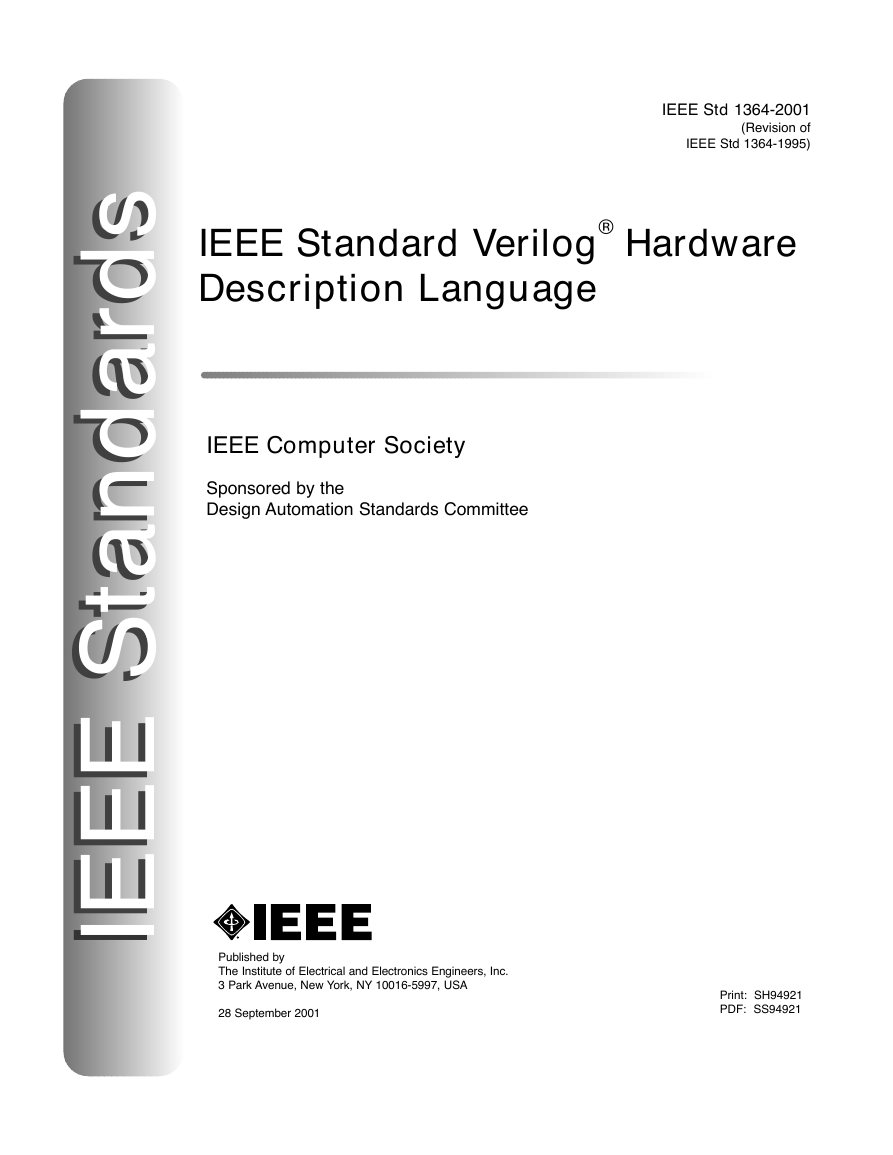
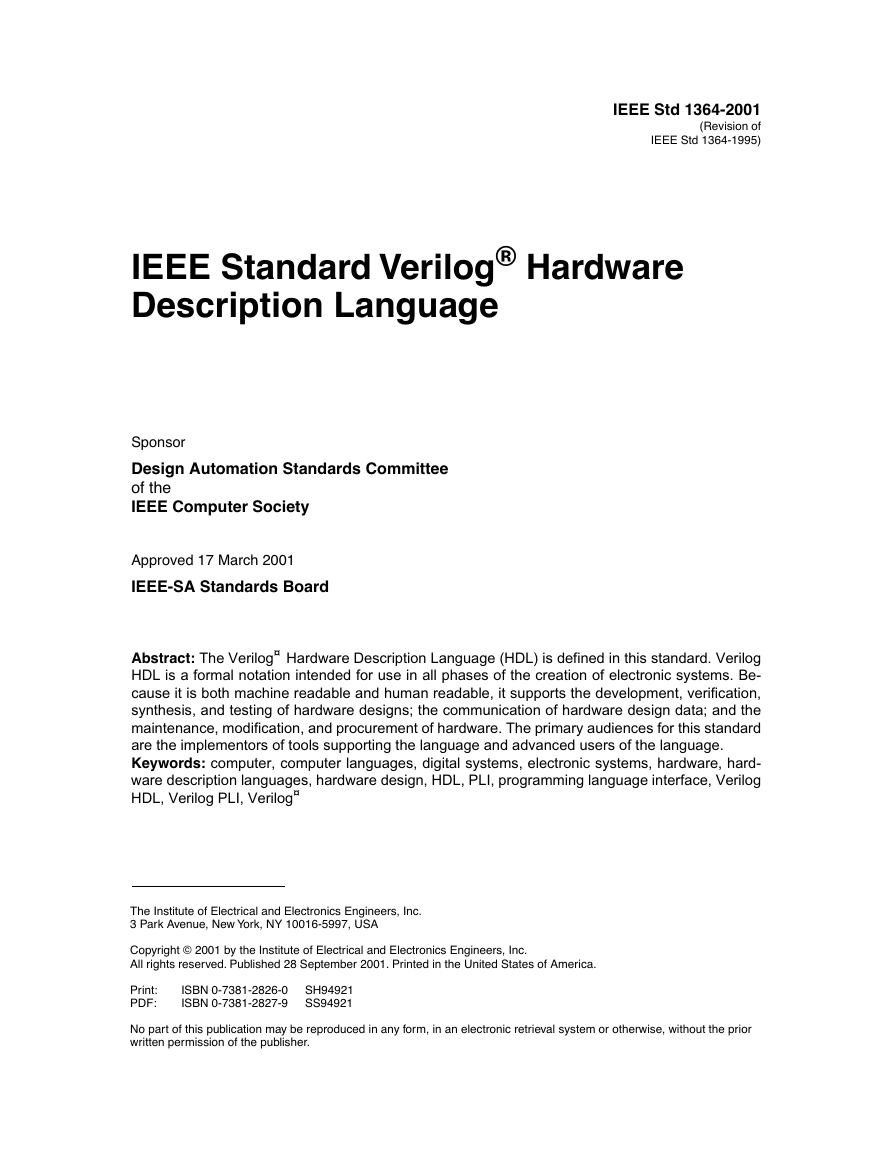
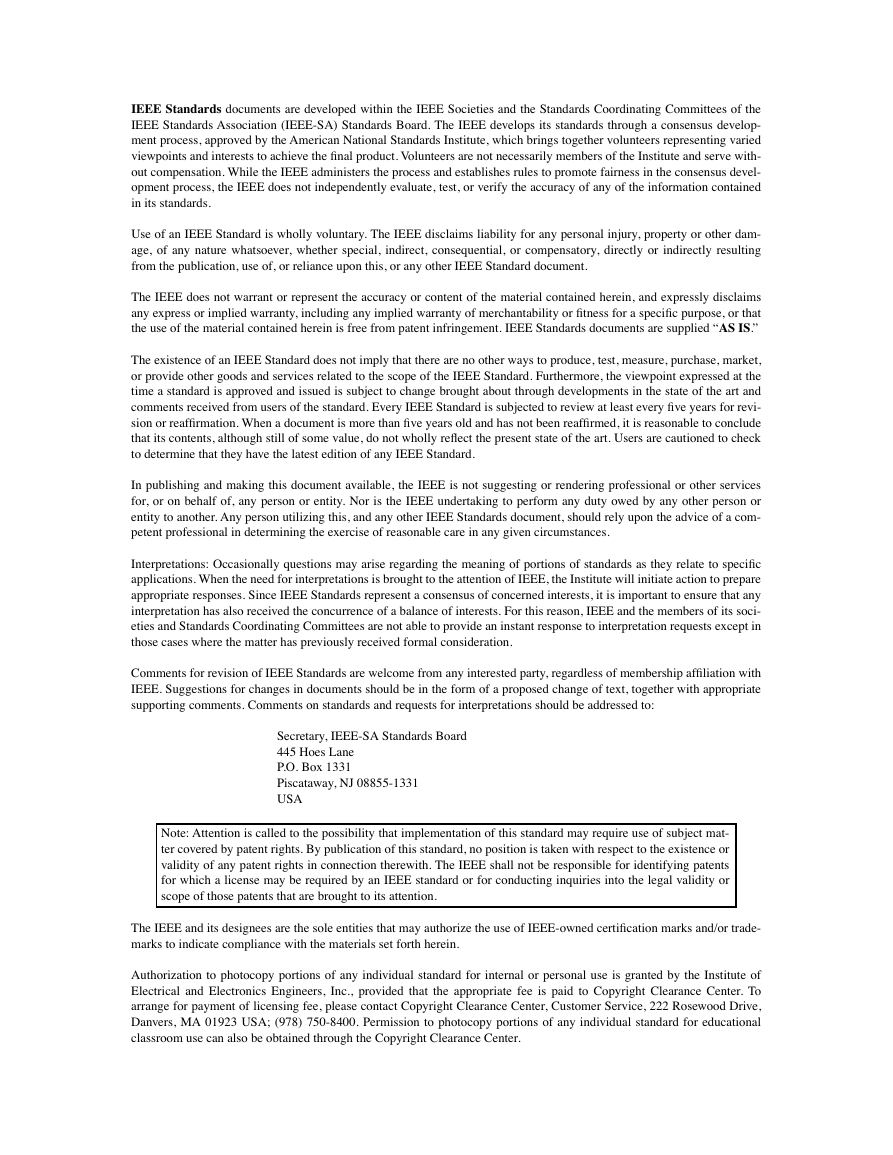
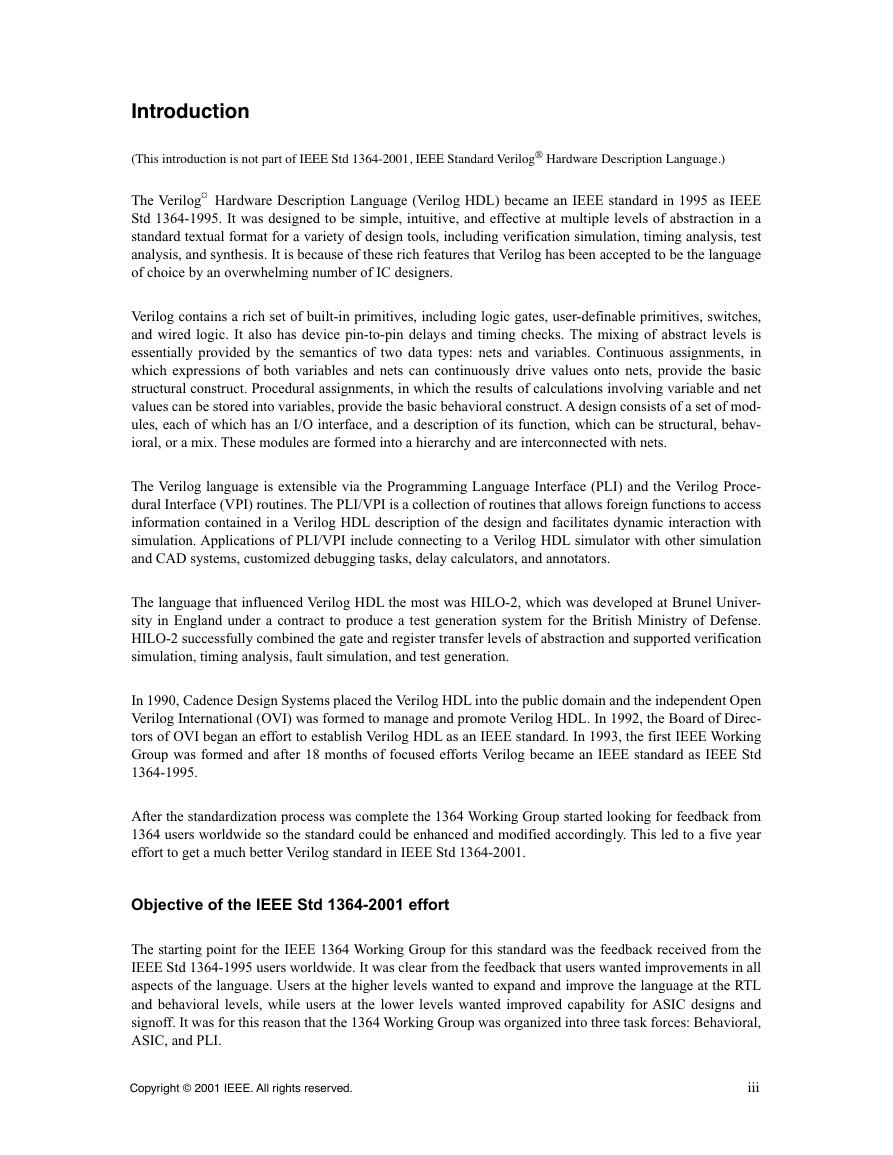
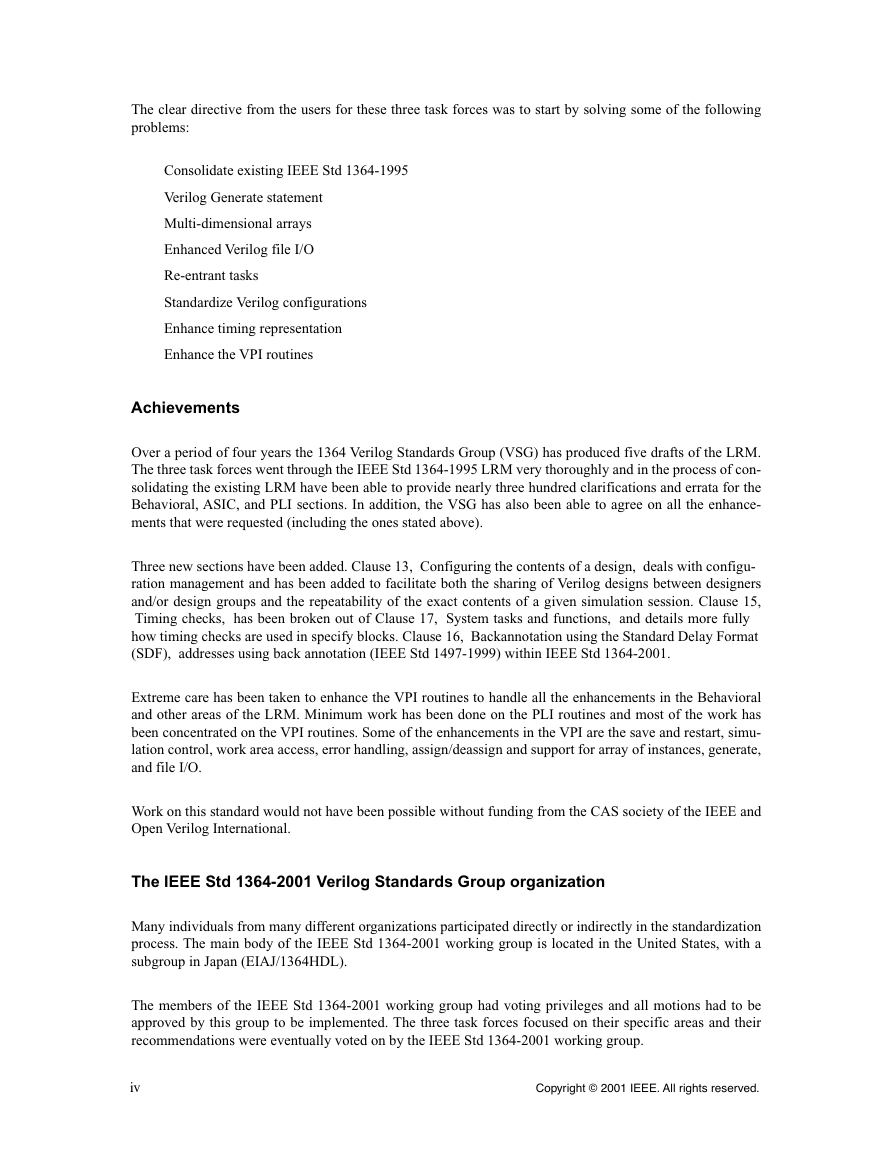
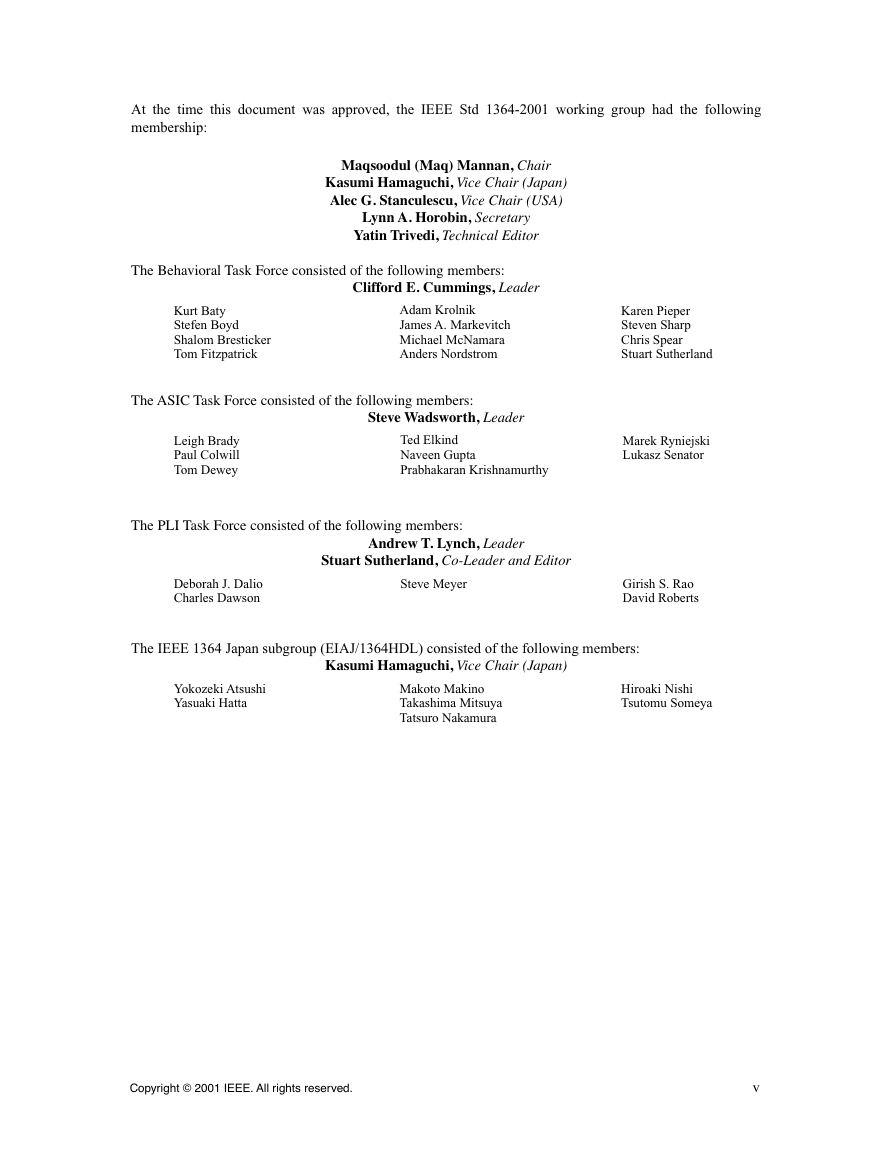
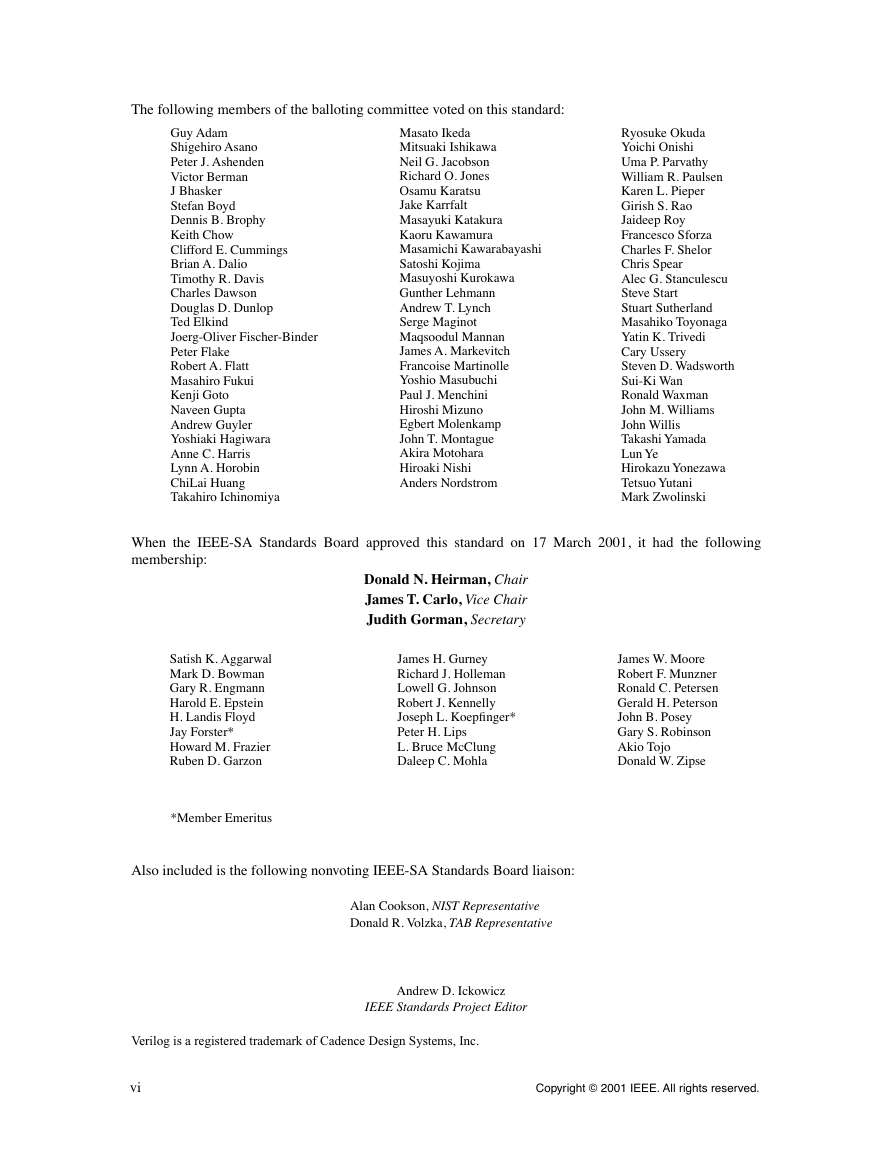









 2023年江西萍乡中考道德与法治真题及答案.doc
2023年江西萍乡中考道德与法治真题及答案.doc 2012年重庆南川中考生物真题及答案.doc
2012年重庆南川中考生物真题及答案.doc 2013年江西师范大学地理学综合及文艺理论基础考研真题.doc
2013年江西师范大学地理学综合及文艺理论基础考研真题.doc 2020年四川甘孜小升初语文真题及答案I卷.doc
2020年四川甘孜小升初语文真题及答案I卷.doc 2020年注册岩土工程师专业基础考试真题及答案.doc
2020年注册岩土工程师专业基础考试真题及答案.doc 2023-2024学年福建省厦门市九年级上学期数学月考试题及答案.doc
2023-2024学年福建省厦门市九年级上学期数学月考试题及答案.doc 2021-2022学年辽宁省沈阳市大东区九年级上学期语文期末试题及答案.doc
2021-2022学年辽宁省沈阳市大东区九年级上学期语文期末试题及答案.doc 2022-2023学年北京东城区初三第一学期物理期末试卷及答案.doc
2022-2023学年北京东城区初三第一学期物理期末试卷及答案.doc 2018上半年江西教师资格初中地理学科知识与教学能力真题及答案.doc
2018上半年江西教师资格初中地理学科知识与教学能力真题及答案.doc 2012年河北国家公务员申论考试真题及答案-省级.doc
2012年河北国家公务员申论考试真题及答案-省级.doc 2020-2021学年江苏省扬州市江都区邵樊片九年级上学期数学第一次质量检测试题及答案.doc
2020-2021学年江苏省扬州市江都区邵樊片九年级上学期数学第一次质量检测试题及答案.doc 2022下半年黑龙江教师资格证中学综合素质真题及答案.doc
2022下半年黑龙江教师资格证中学综合素质真题及答案.doc